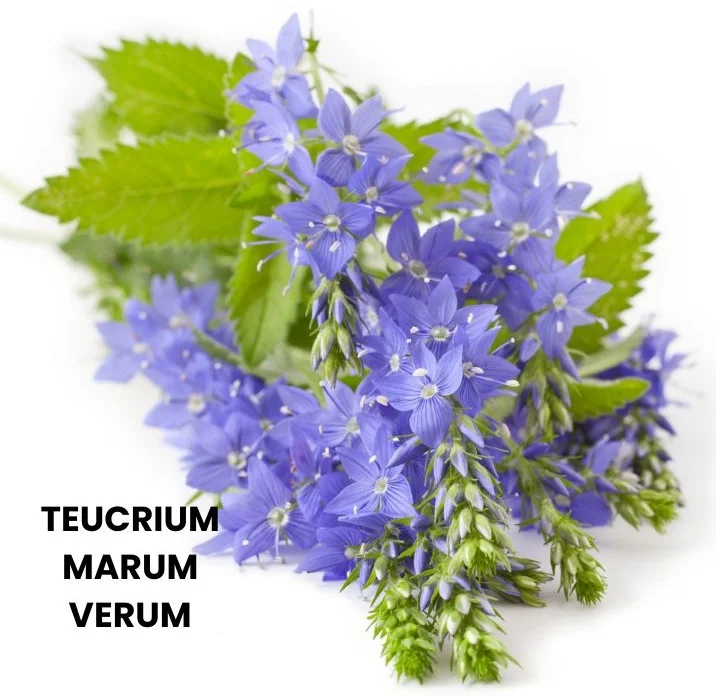Teucrium Marum Verum, commonly known as Cat-thyme, is a significant homeopathic remedy primarily used to address nasal and rectal issues, particularly polyps and chronic nasal catarrh.
It is also indicated for hypersensitive conditions, especially in children and individuals who have been over-medicated.
This remedy’s botanical origin lies in the Teucrium genus, belonging to the Lamiaceae family.
Native to the Mediterranean region, Teucrium species have a long history of medicinal use, especially in traditional herbal medicine.

Table of Contents
ToggleSOURCE INFORMATION
Scientific Classification
- Kingdom: Plantae
- Division: Angiosperms
- Class: Eudicots
- Order: Lamiales
- Family: Lamiaceae
- Genus: Teucrium
- Species: Teucrium marum
Origin and Historical Facts
- Teucrium Marum Verum originates from Mediterranean regions, where it has been used since antiquity.
- The plant has traditionally been employed for its medicinal properties, especially in treating respiratory and digestive disorders.
- Historically, it was utilized by Greek and Roman physicians, and its use was preserved in medieval European medicine.
- The plant’s name, “Teucrium,” is believed to be derived from King Teucer, who used the plant for medicinal purposes.
DRUG PATHOGENESIS
- The pathogenesis of Teucrium Marum Verum involves its profound effect on the mucous membranes, particularly of the nose and rectum.
- It acts by reducing inflammation, promoting the removal of thickened mucus and crusts, and addressing associated polyps.
- Its effects are also noted in conditions of hyper-sensitivity and over-stimulation of the nervous system, particularly after excessive medication.
KEY CHARACTERISTICS
- Nasal and Rectal Symptoms: Nasal polyps, chronic nasal catarrh with thick, offensive crusts, and itching or crawling sensation in the rectum.
- Hypersensitivity: Particularly suitable for children or individuals who have taken too much medication.
- Desire to Stretch: Common in patients needing this remedy.
DETAILED ORGAN SYMPTOMS
NASAL SYMPTOMS
- Polypus: Growth of mucous polyps in the nostrils, which can obstruct breathing.
- Chronic Catarrh: Persistent nasal inflammation, with large, offensive clinkers (dried mucus).
- Loss of Smell: Often related to nasal congestion and polyps.
- Foul Breath: Due to nasal or sinus congestion.
HEAD
- Frontal Headaches: Typically, worse when bending over, often accompanied by a feeling of pressure.
- Tremulous Feeling: General sensation of nervousness and tremors in the head.
EYES
- Smarting Sensation: Especially in the corners of the eyes (canthi), with redness and puffiness of the eyelids.
- Tarsal Tumors: Swellings of the tarsal glands of the eyelids.
EARS
- Ringing and Hissing Sounds: Accompanied by pain (otalgia) in the ears.
STOMACH
- Vomiting: Dark-green vomitus, often associated with hiccoughing and stomach pain.
- Increased Appetite: The patient may feel unusually hungry, yet unable to digest well.
RESPIRATORY
- Dry Cough: Often accompanied by a tickling sensation in the trachea and a moldy taste in the mouth.
- Profuse Expectoration: Expelling large quantities of mucus.
EXTREMITIES
- Tearing Pains: In the arms and legs, particularly affecting the fingers and toes.
- Toe-nail Pain: Sensation of nails growing into the flesh.
RECTUM
- Itching and Crawling Sensation: Particularly in the anus, with irritation at night.
- Restless Nights: Due to itching caused by ascarides (intestinal worms).
SKIN
- Dry Skin: The patient may experience dryness and itching, often severe enough to disturb sleep.
- Suppurating Grooves in Nails: Inflammation and pus formation around the nails.
SLEEP
- Restlessness: Frequently disturbed sleep due to twitching, choking, and feelings of anxiety or fear.
MODALITIES
- Worse: In the evening, while lying down, and from warmth or bed rest.
- Better: From movement and in open air.
WHAT ARE MODALITIES IN HOMOEOPATHY?
RELATIONSHIP WITH OTHER REMEDIES
- Teucrium Scorodonia (Wood-sage): Similar to Teucrium Marum Verum, especially in cases of tuberculosis, glandular problems, and urinary-genital disorders.
- Compare with: Cina, Ignatia, Sanguinaria, Silicea for similar symptoms of nervous system overstimulation and mucous membrane issues.
DOSAGE
- Typically prescribed in the first to sixth potency.
- For nasal polyps, the remedy can also be used as a dry powder for local application.
Frequently Asked Questions
What are the primary uses of Teucrium Marum Verum?
- This remedy is used for nasal polyps, chronic nasal catarrh, rectal irritation, and conditions of hypersensitivity.
How does Teucrium Marum Verum affect the respiratory system?
- It helps alleviate dry coughs and excessive mucus production, often accompanied by a moldy taste in the throat.
Can this remedy help with nail problems?
- Yes, it is indicated for pain in the toe-nails and suppurating grooves around the nails, where pus may form.
Is Teucrium Marum Verum suitable for children?
- Yes, it is often prescribed for children, especially when they experience rectal itching from ascarides (intestinal worms) or nasal issues.
Glossary of Difficult Words
- Polypus: A growth or mass protruding from a mucous membrane.
- Catarrh: Inflammation of the mucous membranes with excessive discharge of mucus.
- Ozaena: A condition characterized by a foul-smelling nasal discharge due to chronic infection.
- Tarsal Tumor: Swelling of the tarsal gland in the eyelid.
- Ascarides: A type of intestinal worm that commonly causes itching and discomfort in the rectum.
- Suppurating: The process of forming pus due to infection.
- Podagra: A term for gout, especially affecting the big toe.
